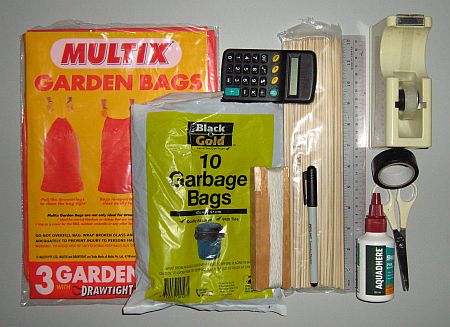
Kite Materials NeededFor The MBK Skewer KitesThe photo shows absolutely all the kite materials needed, plus all the extras such as ruler, marker and scissors. Including the table top!NOTE: This kite materials list was compiled for the 2-skewer kites. For the smaller single-skewer designs, just use plastic freezer-bags for both sails and tails. Also, no electrical tape is used for the single-skewer kites.
Electrical tape, available from hardware stores. This stuff stretches and therefore is perfect for capping spar ends while attaching sail plastic at the same time. Although a bit heavy, only small lengths are required so it doesn't add much weight overall. Lightweight, clear sticky tape. Scotch tape, Sello-tape, sticking tape, whatever you like to call it. Just make sure it is about the width of your finger. The tape I use is 12mm (1/2 inch) in width. This is used to reinforce the edge of the sail, since it doesn't stretch and doesn't add much weight. Large, translucent (see-through), colored plastic bags for making sails. Here in Australia, large orange garden bags are available from supermarkets. These bags are ideal, and also make the finished kite easy to see in the air! Similar bags should be available elsewhere too, perhaps in the form of garbage bags. However, you must be able to see a black marker pen line through the plastic. The MBK construction method relies on this. I've decided to standardize on dark garbage bags, for tails. Despite their size, they are rather light and contrast well with the orange garden bag sails! With a bit of imagination, there are many ways to make kite tails from plastic. Just remember, the lighter the better. Bamboo BBQ skewers. The ones pictured are 30 cm (12 inches) in length, costing just a few dollars for a packet of 100. If yours are a different length, don't worry. These instructions don't rely on absolute measurements for the spars or sail material. You will still end up with a flyable kite. 8 kg (20 pound) or more flying line, for bridles and other lines attached to the frame. These days I'm using 20 pound Dacron for flying line and bridling. You might use Nylon, Polyester or good old cotton. Wood glue, such as the Aquadhere in the photo. Good for tacking kite materials such as bamboo together, although it takes hours to dry. A 100 ml container will last a long time when just used for making MBK kites. If you prefer, and don't mind paying more, there are various quick-drying wood or general-purpose glues on the market that can also be used. The tubes for these are usually much smaller than 100 ml. Now for a few extras you need to help with making an MBK 2-skewer kite... A ruler. Any length or type will do, although a meter (yard) rule is more convenient. The shorter ones often come up short when ruling lines for the 2-skewer kite sails! All MBK kites use straight lines to make things easier. A black marking pen. For drawing corner points and sail outlines on light-colored plastic. The marks need to be easily visible through 2 layers of the plastic. A pair of scissors. These are mainly for cutting around the outline of the sail. They are also handy for snipping bamboo skewers to length. A calculator. Yes, a calculator of some sort, like on your mobile phone or the Windows one or whatever. But there's no heavy calculating to be done! It's just handy for figuring out how long 0.3 x (one skewer length) is, for example. In fact, right now, snip off the point from one of your skewers and measure the skewer. This is 'one skewer length'. Write this measurement down somewhere. A smooth flat space to work on. If you are cutting kite materials with a knife rather than scissors, you will need a smooth flat surface that can be sliced into without upsetting anyone else! So forget the 2-ton 17th Century polished oak table at your rich uncle's house... As long as you have access to a supermarket you should be able to get these kite materials and other bits and pieces together! Half the items are probably lying around your house somewhere already. Last updated: 21 May 2008 Return to How To Make A Kite from Kite Materials All the way back to Home Page |

